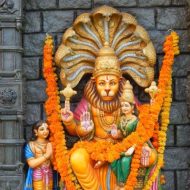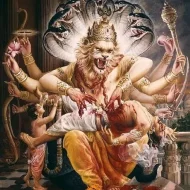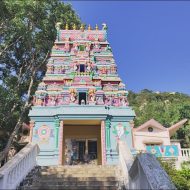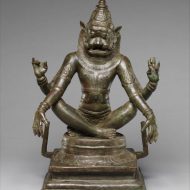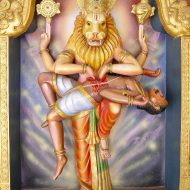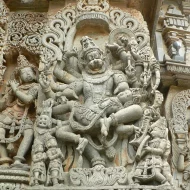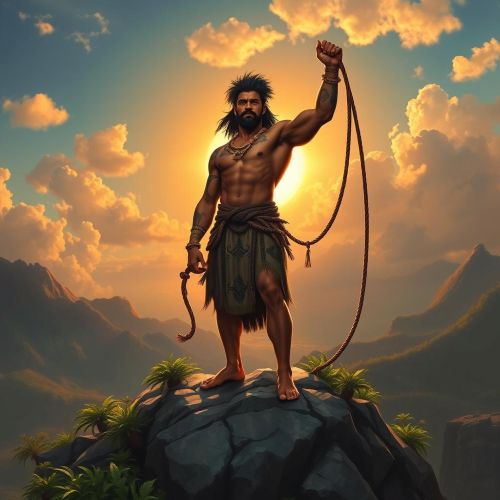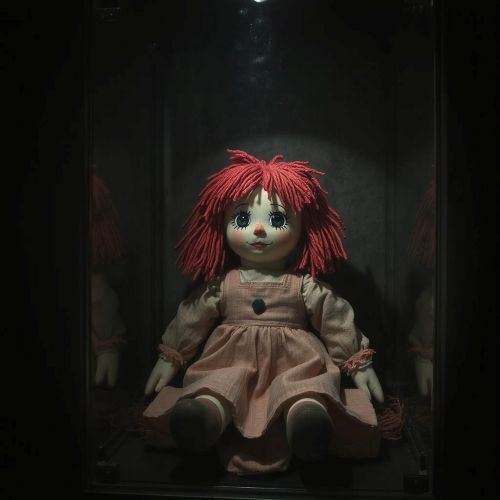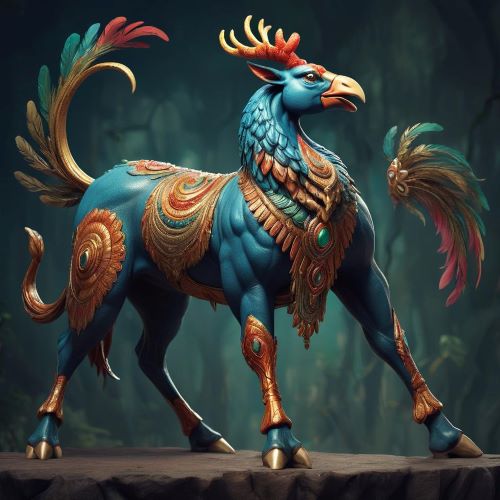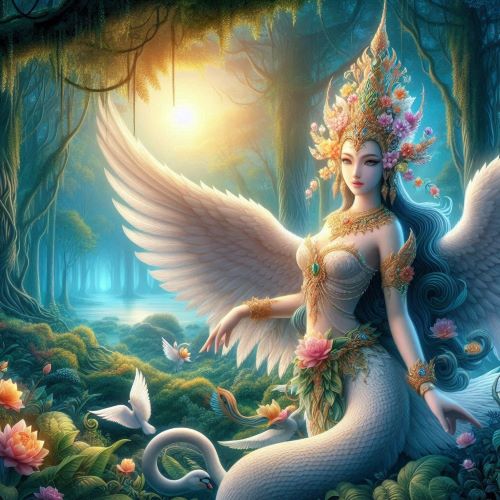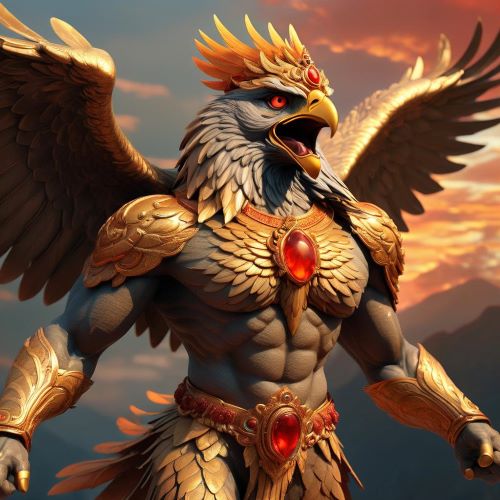Narasimha : The Ultimate Hybrid
Listen
At a glance
| Description | |
|---|---|
| Origin | Indian Mythology |
| Classification | Hybrids |
| Family Members | N/A |
| Region | India, Indonesia, Thailand, Malaysia, Cambodia, Vietnam |
| Associated With | Destruction, Justice |
Narasimha
Introduction
Narasimha, also spelled as Narasingha, is the fourth incarnation of the Hindu deity Vishnu. In this manifestation, he took on the form of a half-lion, half-man being with the purpose of vanquishing Hiranyakashipu, thereby ending religious persecution and turmoil on Earth, and restoring the balance of dharma. Narasimha successfully defeated Hiranyakashipu.
Narasimha, also known as “Man-Lion” in Sanskrit, is one of the ten avatars (incarnations) of the Hindu god Vishnu. This avatar’s story revolves around the demon Hiranyakashipu, who, as the twin brother of Hiranyaksha (overthrown by Vishnu in his previous incarnation as Varaha), had received a powerful boon from the god Brahma. This boon rendered him immune to death by human or animal, whether inside or outside, during day or night, and impervious to any weapon. Feeling invincible, Hiranyakashipu began to wreak havoc upon both heaven and earth.
His own son, Prahlada, however, remained a devoted follower of Vishnu, even though his father threatened his life because of this allegiance. One fateful day, the demon confronted Prahlada and, striking a stone pillar, challenged, “If your god is omnipresent, is he within this pillar as well?” In response, Vishnu emerged from the pillar in the form of a man-lion and vanquished the demon at dusk, at the very threshold of the house.
Physical Traits
Narasimha’s head is one of his most striking features. It takes the form of a lion’s head, complete with sharp teeth and a roaring mouth. This lion’s visage exemplifies his strength and power, underscoring his role as a formidable deity. Adorning his lion’s head is a majestic mane, further enhancing his imposing appearance. The multiple arms of Narasimha, often depicted numbering between four to eight, bear various weapons and symbols that epitomize his divine qualities. These arms signify his ability to simultaneously protect his devotees and defeat malevolent forces. His claws are sharp and potent, highlighting his capacity to both safeguard righteousness and vanquish evil.
Narasimha’s complexion is typically portrayed as golden or yellowish, radiating divine light and auspiciousness. This luminous appearance underscores his transcendental and godly nature. In his stance, Narasimha conveys a sense of heroism and readiness to confront and obliterate evil forces, whether he is depicted standing tall or seated with one leg raised. While Narasimha is often shown wearing traditional garments like a dhoti or a sacred thread, his clothing is not the focal point of his imagery. Instead, his physical form and attributes take precedence. In some depictions, he may be accompanied by his consort, Lakshmi, symbolizing his role as a protector of righteousness and his association with wealth and prosperity.
Family
In Hindu mythology, Narasimha, the divine avatar, engaged in a fierce battle against the demon Hiranyakashipu. This confrontation was rooted in the extraordinary circumstances surrounding Hiranyakashipu’s birth, as his parents had earned the favor of Brahma through their devotion, resulting in the birth of a son with the potential for immense power. Pleased by Hiranyakashipu’s penance, Lord Brahma granted him a boon that rendered him invulnerable to three categories: gods, humans, and beasts. Furthermore, the boon ensured that Hiranyakashipu could not be killed during the day or night, indoors or outdoors.
Empowered by these divine assurances, Hiranyakashipu grew increasingly arrogant and proclaimed himself as a god, forbidding the worship of other deities. His son, Prahlada, remained a devoted follower of Vishnu despite the torment and threats he endured. In a bid to eliminate his son, Hiranyakashipu subjected Prahlada to a series of perilous trials, including drowning, cliff tossing, confinement with poisonous snakes, encounters with lions and elephants, and even attempted immolation. Astonishingly, Prahlada emerged unscathed from each ordeal, steadfastly singing the praises of Vishnu.
Frustrated by his inability to break Prahlada’s devotion, Hiranyakashipu questioned his son about Vishnu’s whereabouts one evening. Prahlada responded that Vishnu was omnipresent, enraging his father. In a fit of anger, Hiranyakashipu struck a pillar at the palace entrance and inquired if Vishnu was within it. Prahlada affirmed, prompting Hiranyakashipu to assault the pillar. To his astonishment, the pillar shattered, and from it emerged Narasimha, who seized the demon king and ultimately vanquished him with his formidable claws. Narasimha’s victory was made possible because he fulfilled all three criteria: he was neither fully human nor beast, he appeared at twilight, and the pillar from which he emerged was neither inside nor outside the house.
In an alternate Shaivic narrative, after liberating the world from Hiranyakashipu’s oppressive rule, Narasimha’s pride swelled. To humble him, Lord Shiva assumed the form of Sharabha, a mythical creature blending aspects of a bird and a lion. Sharabha engaged Narasimha in combat, tearing him apart much as Narasimha had done to Hiranyakashipu. Subsequently, Sharabha wore the man-lion’s skin as a garment, while Narasimha’s face became an ornament adorning Shiva’s chest.
Other names
In the Sanskrit language, the term “Narasimha” is a compound of two words: “nara,” signifying “man,” and “simha,” denoting “lion.” This name alludes to the remarkable avatar of Vishnu, depicted as a man-lion. Furthermore, the term “Singha” is frequently used interchangeably with “Simha,” holding the same meaning of “lion” in Sanskrit and various other Indian languages.
Narasimha is recognized by a variety of names in derivative languages, reflecting his diverse attributes and aspects. These names include Nrisimha, Nrisingha, Narasingha, Narasingh, Narsingh, Narasimba, and Narasinghar. Each of these names sheds light on different facets of his divine persona. For instance, he is referred to as “Agnilochana,” signifying the one with fiery eyes, “Bhairavadambara,” alluding to the deity who inspires terror with his roaring, “Karala,” denoting the entity with a wide mouth and prominent teeth and “Hiranyakashipudvamsa,” emphasizing his role in slaying Hiranyakashipu.
Powers and Abilities
Narasimha, the revered avatar of Lord Vishnu, possesses a formidable array of powers and abilities, each carefully crafted to reflect his divine nature and purpose in Hindu mythology. Central to his character is his invincibility, stemming from Lord Brahma’s boon, which rendered him impervious to harm by gods, humans, or animals. This invulnerability underscores his role as a divine protector and warrior.
One of Narasimha’s most striking attributes is his superhuman strength. His physical prowess allows him to confront and overpower even the most formidable adversaries, making him a symbol of unwavering might. His roar, thunderous and awe-inspiring, strikes fear into the hearts of his enemies, further enhancing his formidable presence. Narasimha’s lion-like claws serve as potent weapons, and his ability to eviscerate malevolent beings with them is a testament to his martial prowess. Often depicted with multiple arms, he wields a range of divine weapons, showcasing his versatility and combat skills.
Modern Day Influence
Narasimha is venerated in numerous forms across the states of Telangana and Andhra Pradesh. It is a common practice to find various depictions of Narasimha within these temples, each representing different aspects of his divine persona. The legends of Narasimha have also found a significant place in various Indian classical dance forms. For instance, in the world of Kathakali theater, the epic battle between Narasimha and Hiranyakasipu has been masterfully incorporated into performances, captivating audiences with this timeless narrative. Additionally, adaptations of the Prahlada Caritam, featuring the divine presence of Narasimha, have become a cherished and popular part of cultural performances in Kerala.
Similarly, the Bhagavata Mela dance-drama traditions of Tamil Nadu have a rich history of celebrating the annual Narasimha Jayanti festival. These vibrant performances take place in regional Narasimha temples and bring to life the enthralling story of Narasimha, captivating both locals and visitors alike with their artistic and devotional expressions.
Related Images
Frequently Asked Questions
What is lorem Ipsum?
I am text block. Click edit button to change this text. Lorem ipsum dolor sit amet, consectetur adipiscing elit. Ut elit tellus, luctus nec ullamcorper mattis, pulvinar dapibus leo.
What is lorem Ipsum?
I am text block. Click edit button to change this text. Lorem ipsum dolor sit amet, consectetur adipiscing elit. Ut elit tellus, luctus nec ullamcorper mattis, pulvinar dapibus leo.
What is lorem Ipsum?
I am text block. Click edit button to change this text. Lorem ipsum dolor sit amet, consectetur adipiscing elit. Ut elit tellus, luctus nec ullamcorper mattis, pulvinar dapibus leo.
What is lorem Ipsum?
I am text block. Click edit button to change this text. Lorem ipsum dolor sit amet, consectetur adipiscing elit. Ut elit tellus, luctus nec ullamcorper mattis, pulvinar dapibus leo.
What is lorem Ipsum?
I am text block. Click edit button to change this text. Lorem ipsum dolor sit amet, consectetur adipiscing elit. Ut elit tellus, luctus nec ullamcorper mattis, pulvinar dapibus leo.

